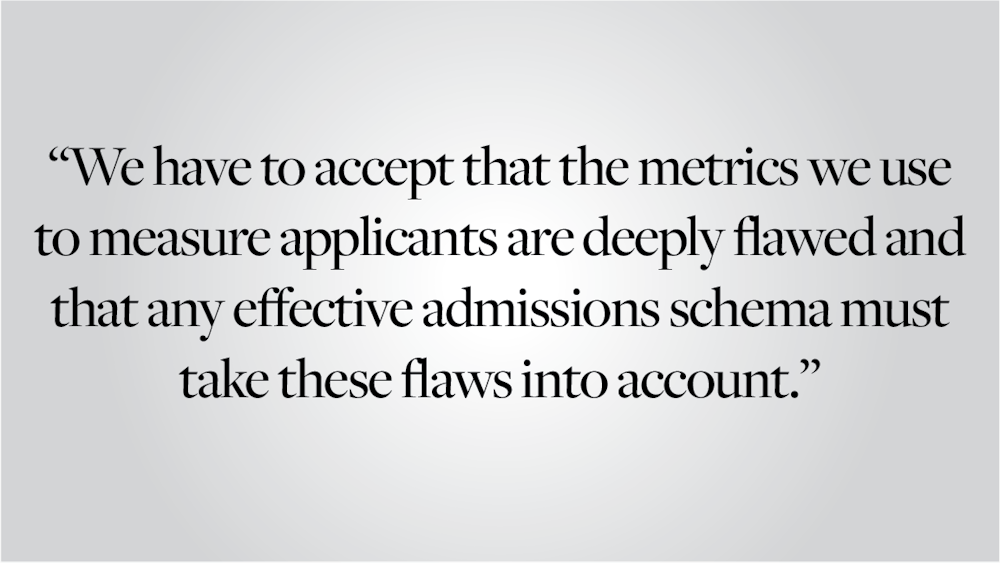On Feb. 5, Dartmouth became the first Ivy League school to reinstate mandatory standardized testing for its 2025-26 admissions cycle. In the coming weeks, Brown’s Ad Hoc Committee on Admissions Policies plans to release a report regarding our current test-optional policy. Brown must follow Dartmouth’s lead and reintroduce mandatory standardized testing into the undergraduate admissions process.
The test-optional movement has been around for decades. In 1969, Bowdoin College became the first school to eliminate its standardized testing requirement. Yet it wasn’t until the early days of the COVID-19 pandemic that colleges and universities began to adopt test-optional policies en masse. Between April and June of 2020, every Ivy League university went test-optional, with Brown announcing its transition to test-optional admissions June 12.
This shift made sense in light of the cancellations and testing site changes necessitated by the onset of the pandemic but has since been refashioned as a matter of social justice. The logic goes that the racial disparities in test scores made them ill-fit to guide admissions decisions and that alternative metrics, such as high-school grade point averages, can more accurately predict success in college. However, a recent study on Ivy-Plus institutions co-authored by John Friedman, the chair of economics at Brown, challenges this theory. The study found that while standardized test scores were highly predictive of GPAs in the first year of college, high school GPAs were ineffective at predicting academic success in college.
Central to the test-optional argument are claims that the tests themselves are biased against racial minorities. There is an element of truth to this: A 2020 Brookings Institution study found that Black students scored an average of 93 points below their white counterparts on the math section of the SAT. Those higher on the socioeconomic totem pole have the resources to pay for test prep services and private tutors, which increases their performance on exams — an indicting statistic, except for the fact that nearly every other component of college applications is also biased.
SAT score disparities merely reflect just another inequity plaguing the college application process. Extracurricular activities require resources that underprivileged minorities lack. Wealthier families are better equipped to put their children through extracurriculars, a phenomenon that has been referred to as the “activity gap.” The dreaded college essay is also tainted by privilege. The personal statement is meant to demonstrate your character and experiences, but among more affluent students, essays are sometimes written by a committee of parents, school counselors and writing services with a nominal contribution from the student themself. Even school GPAs, often touted as an alternative to standardized testing, are subject to similar systemic biases (with a bit of grade inflation for flavor). The connection between socioeconomic status and performance by any metric is clear.
If everything is biased, should we throw our hands in the air and admit the class of ’29 by simple random sampling? While I’m sure some social engineers would have a field day with admissions-by-lottery, the plethora of legal and ethical challenges — antitrust law being one of them — to such a system make it unworthy of further discussion.
Instead, standardized test scores should be interpreted within the context of an applicant’s upbringing. Despite the College Board’s ill-fated attempt to append adversity scores to SATs in 2019 (“Darn, I’d have a perfect score if my parents weren’t happily married!”), the idea that a 1400 from an impoverished first-generation applicant should outweigh a prep-schooler’s 1600 certainly has merit. This is already done to an extent, making the choice to apply test-optional potentially disadvantageous for those of little means. Part of why Dartmouth reinstated mandatory standardized testing was that too many disadvantaged applicants were omitting scores that would have otherwise gotten them accepted.
We have to accept that the metrics we use to measure applicants are deeply flawed and that any effective admissions schema must take these flaws into account. At the same time, proper use of metrics is vital to selecting applicants who can academically flourish once admitted. A decision to deemphasize standardized tests via test-optional policies devalues a valuable predictor of college success.
Victor Chang ’27 can be reached at victor_a_chang@brown.edu. Please send responses to this opinion to letters@browndailyherald.com and other op-eds to opinions@browndailyherald.com.





